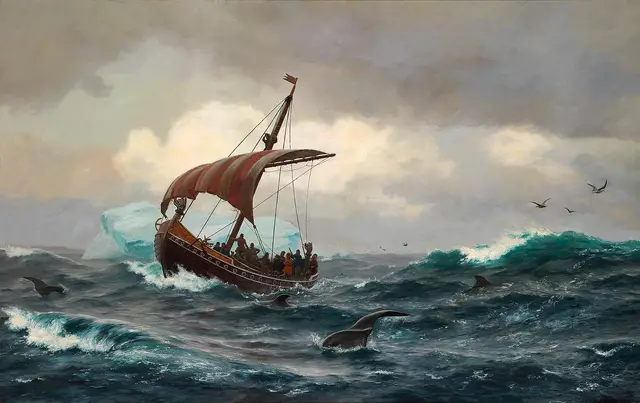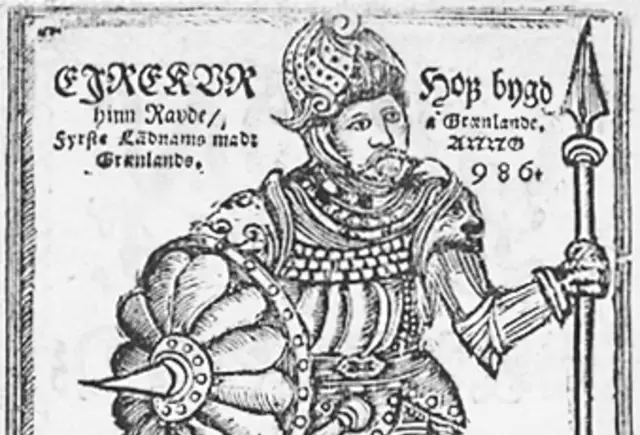Imagine being exiled for murder, sailing into icy oblivion, and somehow turning that into a marketing campaign. That’s exactly what Erik the Red did in the 10th century. And honestly? You kind of have to respect the hustle.
Kicked Out of Iceland. Again.
Erik wasn’t exactly a people person. Born in Norway, he moved to Iceland with his father after his family got exiled for killing someone. Apparently, the apple didn’t fall far from the tree, because Erik himself ended up banished from Iceland after a “disagreement” that left more people dead.
So what does a hot-headed Viking do when no one wants him around? He sets sail west, to a mostly uninhabited, frozen chunk of land. This was probably not Plan A. But it would become legendary.
Welcome to Greenland (Just Ignore the Ice)
Erik spent three years exploring the island. Harsh weather, unforgiving terrain, and almost no trees. But he saw potential, or at least he saw a place where no one could tell him to leave.
When his exile ended, Erik returned to Iceland with an idea. If he wanted people to come live in his frozen outpost, he needed to make it sound, well, a lot less miserable.
He called it “Greenland.”
Yup. Pure branding. Erik figured the name would attract more settlers than something like “Icelandsbutcolder.”
Selling the Dream
Erik pitched Greenland like a Viking timeshare. Fertile land! Open space! No neighbors to argue with! Never mind that the place was mostly ice and rock. The name did some heavy lifting.
In 985, he led a fleet of 25 ships. Only 14 made it. The rest were lost or turned back. The settlers who did arrive carved out a living, building turf houses, farming hardy crops, and raising livestock. It wasn’t paradise, but it was home. For a while.

Life on the Edge
The Greenland Norse survived for a few centuries. They built churches, traded with Europe, and kept records. But life was tough. Climate shifts made growing food even harder. Trade routes dried up. Eventually, the colony vanished. No one’s totally sure why.
Still, for a little while, Erik’s snow-covered paradise became real.
Erik the Family Man (Sort Of)
Erik’s legacy didn’t stop with him. His son, Leif Erikson, took the whole “explorer” thing even further and sailed to North America, centuries before Columbus. Leif might’ve had better PR, but Erik laid the groundwork.
What’s funny is that Erik never actually got to visit the “New World” his son found. He was supposed to go, but he fell off his horse right before the trip and took it as a bad omen. Even the boldest Viking had his superstitions.
It’s a reminder that even legends are ruled by weird little moments. A guy who braved glaciers and exile stayed home because his horse slipped.
How Real Estate Got a Viking Spin
You could argue Erik the Red was an early master of real estate branding. He rebranded a frozen tundra as a green paradise, gathered buyers (settlers), and sold the dream.
That’s not all that different from today’s world. Developers do it with new suburbs. Influencers do it with lifestyles. Politicians do it with, well, everything. Erik just beat them to it by a thousand years.
He understood something a lot of people still don’t: If the story’s good enough, people will buy into it.
The Power of a Name
Let’s talk about that name again. Greenland. It’s almost painfully ironic. Most of the land is anything but green. But in a way, the name itself became a myth that outlived the colony.
It’s like calling a dusty corner café “Paradise Roasters.” You know what you’re walking into, but the name still makes you curious. It sparks a little hope. And that hope gets you through the door.
Erik knew he couldn’t change the land. But he could change how people imagined it.
That, more than swords or ships, was his real power.
Why It Still Matters
We love stories of reinvention. Of bold moves and clever tricks. Erik’s tale is part cautionary tale, part admiration post. Sure, he bent the truth. Sure, he lured people into a difficult life. But he also dared to imagine something new, and got others to imagine it with him.
In a world that often rewards safe choices, Erik took risks. Big, icy, potentially fatal risks. And whether you see him as a con man or a visionary, there’s no denying he left a mark.
Greenland didn’t live up to the name. But it lived on because of the name.
And that’s the weird, wonderful magic of stories. They outlast us. They shape how we see the world. And sometimes, if we tell them just right, they get people to follow us into the snow.
Sources:
1. Britannica – Erik the Red
2. History.com – History of Erik the Red
3. Norse Mythology – Erik the Red

